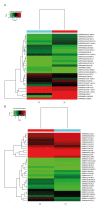Detection and Analysis of the Hedgehog Signaling Pathway-Related Long Non-Coding RNA (lncRNA) Expression Profiles in Keloid
- PMID: 30543583
- PMCID: PMC6301256
- DOI: 10.12659/MSM.911159
Detection and Analysis of the Hedgehog Signaling Pathway-Related Long Non-Coding RNA (lncRNA) Expression Profiles in Keloid
Abstract
BACKGROUND Hedgehog (Hh) signaling pathway-related genes have important roles in several physiological and disease processes that involve cell proliferation. Long non-coding region RNAs (lncRNAs) have a regulatory role on gene expression. Keloid is characterized by excessive proliferation of scar tissue following trauma. The aims of this study were to evaluate the Hh signaling pathway in keloid skin tissues and its downstream gene expression and lncRNAs, compared with normal skin. MATERIAL AND METHODS Four pairs of keloids and adjacent normal skin epidermis underwent total RNA extraction. Gene chip high-throughput real-time quantitative polymerase chain reaction (qPCR) was used to examine the differential expression profiles of the Hh signaling pathway-related lncRNAs and mRNAs in the human keloid and normal skin. The differentially expressed mRNAs were analyzed by Gene Ontology (GO) and the Kyoto Encyclopedia of Genes and Genomes (KEGG) to identify their biological roles. RESULTS In keloid tissue, differential expression of 33 mRNAs and 30 lncRNAs relating to the Hh pathway, were verified by gene chip qPCR. The results of GO and KEGG analysis showed that the upregulated mRNAs were involved in cell proliferation, cell growth, and tissue repair, and down-regulated mRNAs were involved in apoptosis. The lncRNA, AC073257.2, affected cell keloid growth and proliferation by its upstream target the GLI2 gene at the transcriptional level. The lncRNA, HNF1A-AS1, affected cell keloid growth and proliferation by its neighboring target gene, HNF1A. CONCLUSIONS Differential expression occurred in Hh signaling pathway-related lncRNAs and mRNAs, which may provide further insight into the development of keloid.
Figures




Similar articles
-
Identification of skin-related lncRNAs as potential biomarkers that involved in Wnt pathways in keloids.Oncotarget. 2017 May 23;8(21):34236-34244. doi: 10.18632/oncotarget.15880. Oncotarget. 2017. PMID: 28404955 Free PMC article.
-
Expression Profile of Long Noncoding RNAs in Human Earlobe Keloids: A Microarray Analysis.Biomed Res Int. 2016;2016:5893481. doi: 10.1155/2016/5893481. Epub 2016 Dec 22. Biomed Res Int. 2016. PMID: 28101509 Free PMC article.
-
LncRNA expression profiles and validation in keloid and normal skin tissue.Int J Oncol. 2015 Nov;47(5):1829-38. doi: 10.3892/ijo.2015.3177. Epub 2015 Sep 22. Int J Oncol. 2015. PMID: 26397149
-
The crosstalk between long non-coding RNAs and the hedgehog signaling pathway in cancer.Med Oncol. 2022 Jun 18;39(9):127. doi: 10.1007/s12032-022-01710-2. Med Oncol. 2022. PMID: 35716241 Review.
-
Unravelling the role of long non-coding RNAs in modulating the Hedgehog pathway in cancer.Pathol Res Pract. 2024 Feb;254:155156. doi: 10.1016/j.prp.2024.155156. Epub 2024 Jan 26. Pathol Res Pract. 2024. PMID: 38309021 Review.
Cited by
-
Aberrantly Expressed Small Noncoding RNAome in Keloid Skin Tissue.Front Genet. 2022 Apr 13;13:803083. doi: 10.3389/fgene.2022.803083. eCollection 2022. Front Genet. 2022. PMID: 35495137 Free PMC article.
-
Long non-coding RNA CACNA1G-AS1 promotes proliferation and invasion and inhibits apoptosis by regulating expression of miR-205 in human keloid fibroblasts.Biosci Rep. 2020 Jun 26;40(6):BSR20192839. doi: 10.1042/BSR20192839. Biosci Rep. 2020. PMID: 32495824 Free PMC article.
-
LINC00937 suppresses keloid fibroblast proliferation and extracellular matrix deposition by targeting the miR-28-5p/MC1R axis.Histol Histopathol. 2021 Sep;36(9):995-1005. doi: 10.14670/HH-18-372. Epub 2021 Aug 23. Histol Histopathol. 2021. PMID: 34486677
-
Progress in the clinical treatment of keloids.Front Med (Lausanne). 2023 Nov 16;10:1284109. doi: 10.3389/fmed.2023.1284109. eCollection 2023. Front Med (Lausanne). 2023. PMID: 38046417 Free PMC article. Review.
-
An updated review of the immunological mechanisms of keloid scars.Front Immunol. 2023 Mar 22;14:1117630. doi: 10.3389/fimmu.2023.1117630. eCollection 2023. Front Immunol. 2023. PMID: 37033989 Free PMC article. Review.
References
-
- Profyris C, Tziotzios C, Do Vale I. Cutaneous scarring: Pathophysiology, molecular mechanisms, and scar reduction therapeutics Part I. The molecular basis of scar formation. J Am Acad Dermatol. 2012;66:1–12. - PubMed
-
- Butler PD, Longaker MT, Yang GP. Current progress in keloid research and treatment. J Am Coll Surg. 2008;206:731–41. - PubMed
-
- Zhao L, Kong H, Sun H, et al. LncRNA-PVT1 promotes pancreatic cancer cells proliferation and migration through acting as a molecular sponge to regulate miR-448. J Cell Physiol. 2017;10:1002. - PubMed
MeSH terms
Substances
LinkOut - more resources
Full Text Sources

